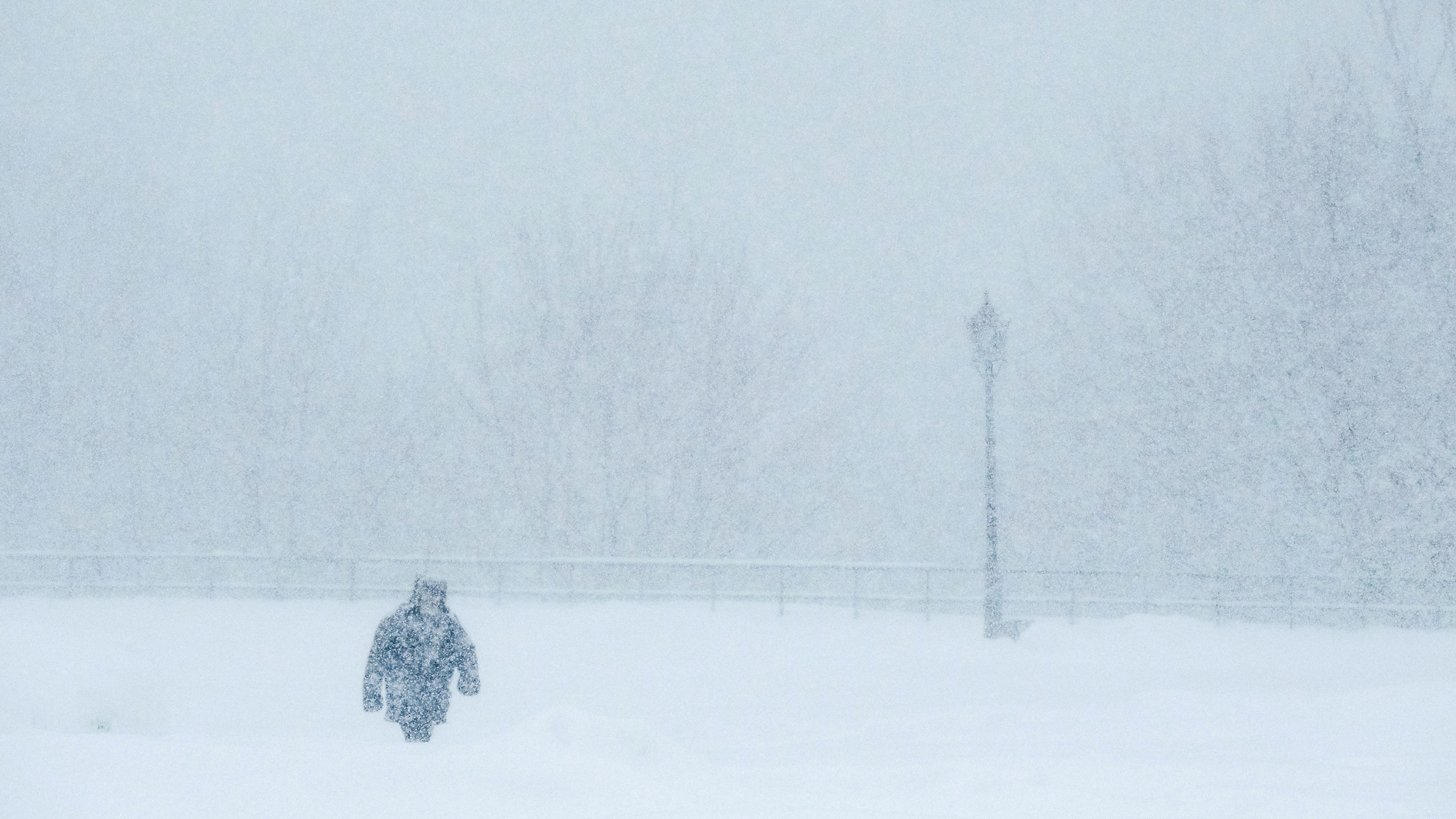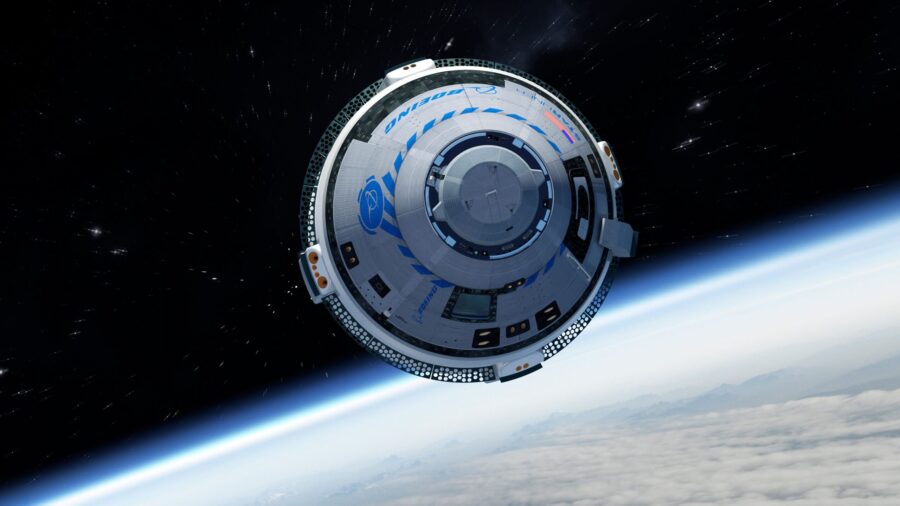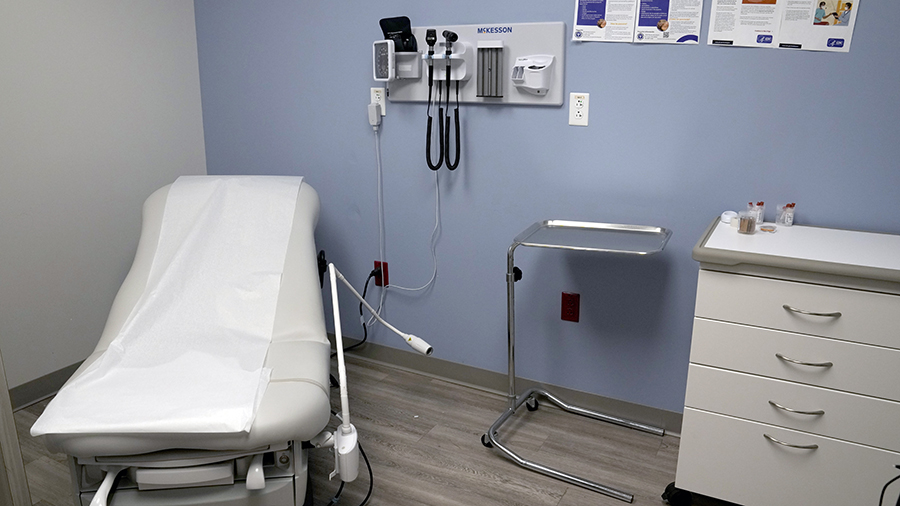You’re trapped in a blizzard. Do you know what to do next to survive?
Feb 3, 2022, 4:55 PM | Updated: Jun 8, 2022, 3:18 pm

TOPSHOT - A man walks during a strong snowfall at the Kolomenskoye museum-reserve in Moscow on February 4, 2018. / AFP PHOTO / Yuri KADOBNOV (Photo credit should read YURI KADOBNOV/AFP via Getty Images)
(Photo credit should read YURI KADOBNOV/AFP via Getty Images)
(CNN) — Warm thoughts of young romance — not the cold, harsh possibilities of a Midwestern road trip in winter — were on Dawn O’Hair’s mind as she left Chicago for Indianapolis to see her boyfriend.
Her weekend visit, back in the winter of 1997-98, did not go well. After a spat with her beau, O’Hair got back into her car very early on a Monday morning to return to Chicago and her job.
She should have stayed put. The 23-year-old was driving up Interstate 65 straight into a blizzard.
“I ended up in whiteout conditions. I had trouble maintaining control in my 1995 Chevrolet Cavalier,” she said. “The wind was crazy. The snow was blowing sideways. It was super hard to see. It was horrible.”
“I got nervous and decided to pull over [but] my car got stuck,” she said. “I didn’t know what to do. I got out and tried to figure out a way to get traction, but without luck.”
And there she was — in a real mess. She hadn’t checked the forecasts. She had nothing particularly warm to wear. No blankets. No winter kit. Just her Chevy and time to ponder how things went so wrong so fast.
O’Hair’s story is a far too common one of people caught off guard by a blizzard or some other onslaught of wintry weather.
Blizzards can happen over a surprisingly wide range of the calendar — just ask these runners caught in a blizzard in October in Utah.
But January and February are definitely a prime time for them. Last weekend, millions were coping with blizzard conditions in the Mid-Atlantic and Northeast.
More than 100 million people in 25 states stretching from the Mexican to Canadian borders were under various winter weather alerts Thursday. A blizzard warning was in effect for Valdez, Alaska, in a separate winter storm.
Unless you live in a year-round warm climate and plan to stay there, it’s important to know how winter storms behave, how to avoid and prepare for them, and heaven forbid, what to do in the worst-case scenario.
What’s a blizzard? And why are they so dangerous?
First, not every ol’ winter storm is technically a blizzard.
The National Weather Service says a blizzard must have large amounts of falling snow or blowing snow, winds greater than 35 mph (56 kph) and visibility of less than a quarter mile (0.4 km) for at least three hours. A ground blizzard has no falling snow; instead, it blows around snow that had fallen before the blizzard kicked up.
Any weather system with below freezing temperatures along with snow and ice can be a safety hazard. Blizzards, however, are one of the most dangerous types of winter storms.
They can lead not only “to perilous driving conditions under low visibility and snow-covered roads, but can also lead to disorientation for anyone walking or driving, resulting in the person not knowing where they are or where they are going,” said Michael Muccilli, meteorologist with the National Oceanic and Atmospheric Administration’s NWS, in an email interview with CNN Travel.
“Oftentimes the strong winds and cold temperatures associated with blizzards can produce dangerous wind chills, which can lead to hypothermia and frostbite, especially if stuck outside for extended periods,” he said.
Your first line of defense
Awareness and avoidance are your best weapons against blizzards and other bad winter weather.
If you’re taking a road trip, “begin checking weather conditions about a week in advance of your trip and make sure to check again each day as the weather forecasts become more fine-tuned,” Muccilli said.
“Have alternate plans for your travel, and if weather conditions are looking increasingly unfavorable, use those alternate plans or delay travel.”
Muccilli said you should check conditions along your entire route, not just the starting and ending points, especially if you’re crossing through high mountain passes.
If you’re going hiking or camping, checking forecasts is a must, said Beth Pratt, the California regional executive director for the National Wildlife Federation.
Don’t skip a forecast check just because it’s fall, spring or even summer in some locations. They can lull you into a false sense of security because your guard might not be up as much as the dead of winter, Pratt said.
She resides on the border of Yosemite National Park in the Sierra Nevadas, where you might start out on a hike on a late fall day while it’s still warm but suddenly encounter a dangerous wintry blast.
NOAA has nine winter forecast tools you can check online to see what might be ahead.
Where do blizzards happen?
A little geographical and climate knowledge helps, too.
“Blizzards are most common in the upper Midwest and Great Plains in the United States, but can occur in most areas of the country except the Gulf Coast and coastal California,” Muccilli said. Elsewhere in the world, you’ll encounter them most often in Russia, central and northeastern Asia (including China), northern Europe, Canada and Antarctica.
Just as it’s important to know blizzards aren’t a winter-only event, you must also realize they might happen in places you usually associate with hot weather.
Iran was struck by a 1972 blizzard that killed thousands. At least four people died in Spain early in 2021 in a rare blizzard. And parts of inland Alabama, Georgia and the Carolinas were slammed by blizzard conditions in the 1993 storm of the century.
Dress for success
Having the right clothing is crucial if you’re going to a place where blizzards and other cold-weather storms might happen.
The American Red Cross says to “wear layered clothing, mittens or gloves, and a hat. Outer garments should be tightly woven and water repellent. Mittens or gloves and a hat will prevent the loss of body heat.”
Remember O’Hair’s predicament. It’s important to bring along winter clothing even if it’s not that cold or threatening as you depart or you just plan on staying in your car.
Layering is important, says the Massachusetts government website: “Dress in several layers of loose-fitting, lightweight clothing instead of a single heavy layer.”
Minnesota’s state government points out another reason to layer: You might need to take a layer or two off to avoid overheating, perspiring too much and then subsequently getting chilled. The website advises mittens over gloves.
If you’re outside, the Red Cross also says to cover your mouth to protect your lungs from severely cold air. Don’t gulp in deep breaths of frigid air and talk as little as possible.
Road trips
Make sure you have fully stocked safety kit before you head out. Muccilli said the kit should include:
— A survival blanket
— Road salt and a shovel
— A scraper
— Jumper cables
— Drinking water
— A repair kit
— A flashlight and road flares
— A cell phone charger
You should also fill your wiper fluid and check your tire pressure, tire tread and oil before leaving. Make sure your phone is fully charged.
What if you run into bad winter weather?
“If the weather becomes too severe to continue driving, pull over, and if possible move your car to the closest gas station or hotel and ride out the storm,” Muccilli said. Don’t drive around barriers onto closed-off roads.
What if your car is stuck in the snow?
If conditions are safe enough, you can “attempt to shovel out your tires and throw down sand, rock salt, dirt, cardboard or kitty litter to give your vehicle more traction. If this does not work, call for roadside assistance or emergency services.”
Otherwise, Muccilli said stay inside your vehicle except long enough to set road flares or put out a colorful cloth to make yourself visible. Contact emergency services with as much information about your situation as you can.
The NWS advises not to leave your vehicle to walk for help during a blizzard. You could get disoriented. You should run the motor about 10 minutes each hour for heat, it says, but open the window a crack for fresh air. Clear snow away from the exhaust pipe if possible.
Outdoor excursions
Whether you are camping, hiking, backcountry skiing or doing other similar types of outside activities, carry the correct safety gear. Muccilli said this might include but is not limited to:
— Proper footwear
— Enough water and food
— A headlamp and a lighter
— A whistle
— A first aid kit
— A map or other navigation tools
— A transceiver to transmit your location in case you are trapped in an avalanche
— A probe to pinpoint your exact location
— A shovel to dig out
— An airbag pack to increase your chances of staying near the surface of an avalanche.
“Never hike or ski alone and make sure someone knows where you are going,” he said.
If you’re at a ski resort
People enjoying a day (or night) at a ski resort should check the local weather forecast just before heading out to the slopes, said Rick Shandler, national program director of the Safety Team at National Ski Patrol.
He cautions skiers to not let their investment in a pricey lift ticket cloud their judgment.
“People want to get the most value out of their lift tickets and may stay out past what common sense dictates” when blizzards, dense fog or other bad weather is approaching, he said.
He suggested taking the following with you on the slopes:
— A fully charged cell phone in an inner pocket. The cold can quickly sap your battery if it’s in an outer pocket. Get the number of the ski patrol at the resort before you head out and add it to your phone.
— A whistle. The sound carries farther than yelling if you’re down and a ski patrol needs to find you.
— A space blanket. Made of Mylar, they are inexpensive, easy to tote and can keep you warmer and easier to spot if you become stranded.
Worst-case scenarios
Pratt said the closest she ever came to dying in a blizzard was in her college years back in 1990. It was in June of all months, while she was hiking with two friends on Mount Washington in New Hampshire.
The mountain is notorious for its dangerous, fickle weather, even in summer.
“The storm came up very fast. We were in college, and young and broke and didn’t have great gear either.”
With the wind whipping and whiteout conditions of a blizzard, “the only thing that saved us is we found the tracks to the Mount Washington Cog Railway. So we had breadcrumbs to follow. If we had not been near those train tracks, we would have had to hunker down. The wind was so fierce it had shredded our rain gear.”
What if you end up in a worst-case scenario like Pratt? She said there are “two things to focus on: Stay warm and stay still.”
“It’s ill-advised to walk yourself out of a blizzard. Navigation is tough, and you burn more energy when you are cold, so conserve it. Find shelter. If there is none to find, build a snow cave if there’s enough snow. Wait it out.”
The NWS has some additional advice for dire situations when it’s just you vs. the raw elements:
— Try to find shelter: Also, attempt to stay dry and cover all of your body.
— Can’t find shelter? See if you can make a lean-to, windbreak or snow cave for protection from the wind. Try to set a fire. If there are rocks nearby, put those around the fire to retain heat. Global Rescue says even low-hanging tree branches could provide some protection.
— Out of water? You should melt snow for drinking water. The NWS and Global Rescue warn that eating unmelted snow will lower your body temperature.
— Strategic exercise: From time to time, move your arms, legs, fingers and toes to keep your blood pumping and stay warm. But don’t overdo it. “The strain from the cold and the hard labor may cause a heart attack. Sweating could lead to a chill and hypothermia,” the NWS website says.
Lessons learned and a happy ending
Fortunately for Dawn O’Hair, what she lacked in winter preparation she made up for in a good decision, good luck and good connections with people in northern Indiana.
She wisely stayed with her car instead of walking off into the blizzard for help.
Less than an hour later, a young woman pulled up and offered her a ride to a gas station. That woman had a boyfriend who was a police officer, and he took her to an Indiana state police post. From the post, she was able to reach a cousin to give her refuge and was transported to that cousin’s house via snowmobile.
It ended up taking her several days and more on-the-road misadventures to make the roughly 170-mile drive back home.
So what did Dawn O’Hair Czanik — yes, she ended up marrying the boyfriend with whom she had the spat — learn from the experience?
“I would have paid more attention to the weather forecast and planned ahead better! I probably would have left the day before, but young love is kinda stupid, ya know?”
The-CNN-Wire
™ & © 2022 Cable News Network, Inc., a WarnerMedia Company. All rights reserved.













